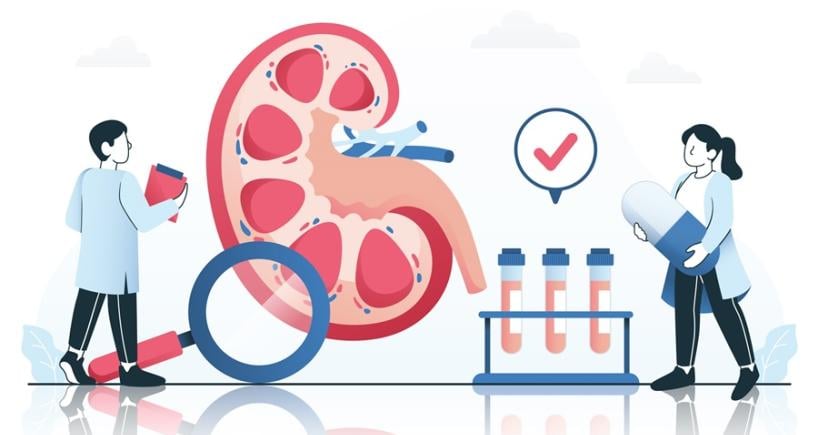
Untangling the Interconnection Between Diabetes and Liver Disease
Introduction
Did you know that type 2 diabetes and being overweight can put an individual at an increased risk for certain forms of liver disease?
The liver is one of the most crucial organs in an individual’s body, playing a key role in several significant processes.
One of these is to help control glucose levels in the blood (i.e., regulating blood glucose levels).
A healthy liver helps keep blood glucose or sugar within the “normal range” and shields against excessive blood sugar fluctuations.
Broader Perspective: The Connection Between Type 2 Diabetes and Liver
The interconnection between type 2 diabetes and liver disease is only recently discovered, but it’s becoming exceedingly clear that one complements the other. When the blood sugar levels of an individual are consistently high over a long duration of time, it damages the internal organs, including the liver. Similarly, NAFLD and NASH raise the chances of developing prediabetes or type 2 diabetes. A buildup of fat and liver damage can raise blood sugar levels. NAFLD and type 2 diabetes also share many similar risk factors, including overweight or obesity, high blood pressure, and elevated cholesterol levels. Researchers are observing increasing numbers of individuals suffering from both type 2 diabetes and liver disease. Up to 70% of individuals suffering from type 2 diabetes also have NAFLD.
Roll Up Your Sleeves: Getting Screened
NAFLD and NASH generally do not manifest any signs or symptoms and can develop over many years unnoticed. Some individuals may experience a loss of appetite, fatigue, yellowing of the skin and/or eyes, right-sided pain in the belly, or unexplained shedding of pounds. However, most individuals don’t notice any of these during the early stages of liver disease. Because of this, screening and early diagnosis become crucial, even if they don’t think anything is wrong. Healthcare professionals can screen an individual for NAFLD by assessing liver enzymes (an estimate of liver function) with simple blood tests. The test results and the individual’s age are utilized to calculate the risk for hepatic damage. An individual’s risk score, known as the Fibrosis-4 (FIB-4) Index, signifies the following:
- FIB-4 score of less than 1.3 denotes low risk
- FIB-4 score ranging from 1.3 to 2.67 denotes medium risk
- FIB-4 score of more than 2.67 indicates high risk
The FIB-4 score of an individual displays the risk of liver disease, and healthcare professionals might also perform a liver biopsy to diagnose liver disease if needed. Imaging tests, such as ultrasound, computed tomography (CT) scan, or magnetic resonance imaging (MRI), can indicate how much excess fat an individual has in their liver. Diabetes experts are observing that chronic liver disease is a growing health concern among diabetics. Early diagnosis and lifestyle alterations for NAFLD can aid in preventing more critical forms of hepatic damage, such as cirrhosis.
Connecting Dots: Non-Alcoholic Fatty Liver Disease (NAFLD) and Diabetes
- NAFLD refers to a diabetes-related condition that causes the buildup of excessive fat in the liver.
- This condition occurs in at least 50% of individuals suffering from type 2 diabetes and close to half of those suffering from type 1 diabetes, and unlike other hepatic problems, it is not associated with alcohol intake.
- The chances of developing this disease are elevated by the presence of diabetes as well as raised by other medical conditions associated with diabetes.
The prevalence of non-alcoholic fatty liver disease condition is known to elevate the risk of inflammation of the liver or scarring (cirrhosis) and is also linked with elevated risk of liver cancer and cardiac disease.
What is Hepatogenous Diabetes?
The diabetogenic capability of liver cirrhosis has been known for a long time, and the name “hepatogenous diabetes” (HD) was formulated to define this condition. Diabetes mellitus (DM) that develops because of liver cirrhosis is referred to as HD. In patients suffering from liver cirrhosis, the prevalence rates of HD vary from 21% to 57%. The pathophysiological basis of HD seems to comprise insulin resistance (IR) and pancreatic β-cell dysfunction.
Balancing the Liver and Diabetes Equation the Right Way
- With healthy lifestyle modifications, an individual may be able to prevent, slow down, or even reverse the buildup of excess liver fat. For example, shedding pounds if an individual is overweight or suffering from obesity is a great place to start. Losing 5% to 10% of the current body weight can aid in decreasing extra fat in the liver, improve blood glucose or sugar levels, and take the stress off all internal organs.
- Healthy eating, comprising balancing carbohydrate consumption and limiting sweets, is significant for diabetes management. It also matters for hepatic health since extra carbohydrates and sugars are stored in the liver. Limiting the quantity of saturated fats in the diet helps protect the liver from fat buildup.
- Being physically active enhances the way the body utilizes blood sugar and decreases the fat stored in the liver. At least 3 hours of rigorous physical activity per week is recommended. But every bit of activity counts, even if an individual has few minutes to spare. Limiting alcohol can also decrease the stress on the liver and delay the development of hepatic damage. Limiting alcohol consumption is also crucial for an individual if they are suffering from liver disease or are at risk for it.
- Making and adhering to healthy lifestyle modifications might seem difficult at first, but even reaching partial goals can help individuals prevent, delay, or manage type 2 diabetes, liver disease, and other associated long-term health conditions.
In case of persisting liver symptoms related to diabetes, seek immediate medical attention.
Popular Searches :
Hospitals: Cancer Hospital in Delhi | Best Heart Hospital in Delhi | Hospital in Amritsar | Hospital in Ludhiana | Hospitals in Mohali | Hospital in Faridabad | Hospitals in Gurgaon | Best Hospital in Jaipur | Hospitals in Greater Noida | Hospitals in Noida | Best Kidney Hospital in Kolkata | Best Hospital in Kolkata | Hospitals in Rajajinagar Bangalore | Hospitals in Richmond Road Bangalore | Hospitals in Nagarbhavi Bangalore | Hospital in Kalyan West | Hospitals in Mulund |
Doctors: Dr. Rana Patir | Dr. Rajesh Benny | Dr. Rahul Bhargava | Dr. Jayant Arora | Dr. Anoop Misra | Dr. Manu Tiwari | Dr. Praveer Agarwal | Dr. Arup Ratan Dutta | Dr. Meenakshi Ahuja | Dr. Anoop Jhurani | Dr. Shivaji Basu | Dr. Subhash Jangid | Dr. Atul Mathur | Dr. Gurinder Bedi | Dr. Monika Wadhawan | Dr. Debasis Datta | Dr. Shrinivas Narayan | Dr. Praveen Gupta | Dr. Nitin Jha | Dr. Raghu Nagaraj | Dr. Ashok Seth | Dr. Sandeep Vaishya | Dr. Atul Mishra | Dr. Z S Meharwal | Dr. Ajay Bhalla | Dr. Atul Kumar Mittal | Dr. Arvind Kumar Khurana | Dr. Narayan Hulse | Dr. Samir Parikh | Dr. Amit Javed | Dr. Narayan Banerjee | Dr. Bimlesh Dhar Pandey | Dr. Arghya Chattopadhyay | Dr. G.R. Vijay Kumar | Dr Ashok Gupta | Dr. Gourdas Choudhuri | Dr. Sushrut Singh | Dr. N.C. Krishnamani | Dr. Atampreet Singh | Dr. Vivek Jawali | Dr. Sanjeev Gulati | Dr. Amite Pankaj Aggarwal | Dr. Ajay Kaul | Dr. Sunita Varma | Dr. Manoj Kumar Goel | Dr. R Muralidharan | Dr. Sushmita Roychowdhury | Dr. T.S. MAHANT | Dr. UDIPTA RAY | Dr. Aparna Jaswal | Dr. Ravul Jindal | Dr. Savyasachi Saxena | Dr. Ajay Kumar Kriplani | Dr. Nitesh Rohatgi | Dr. Anupam Jindal |
Specialities: Heart Lung Transplant | Orthopedic |
















}}drupal-data/images/blog-lists.png)


